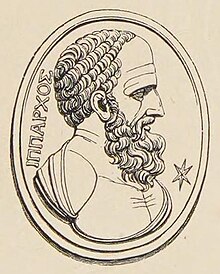ฮิปปาร์โคส
ฮิปปาร์โคส (กรีก: Ἵππαρχος, Hipparkhos; ประมาณ 190 – 120 ปีก่อน ค.ศ.) เป็นนักดาราศาสตร์ นักภูมิศาสตร์ และนักคณิตศาสตร์ชาวกรีก ถือเป็นผู้ก่อตั้งศาสตร์ด้านตรีโกณมิติ[1] แต่มีชื่อเสียงสุดในด้านการค้นพบการเคลื่อนถอยของวิษุวัตโดยบังเอิญ[2] ฮิปปาร์โคาเกิดที่ไนเซีย บิธีเนีย และน่าจะเสียชีวิตบนเกาะโรดส์ ประทเศกรีซ เขาทำงานเป็นนักดาราศาสตร์ใน 162 ถึง 127 ปีก่อน ค.ศ.[3]
ฮิปปาร์โคส | |
|---|---|
 | |
| เกิด | ประมาณ 190 ปีก่อน ค.ศ. ไนเซีย อาณาจักรบิธีเนีย (ปัจจุบันอยู่ที่อิซนิก บูร์ซา ประเทศตุรกี) |
| เสียชีวิต | ประมาณ 120 ปีก่อน ค.ศ. (ประมาณ 70 ปี) โรดส์ สาธารณรัฐโรมัน (ปัจจุบันคือประเทศกรีซ) |
| อาชีพ | |
ฮิปปาร์โคสถือเป็นผู้สังเกตการณ์ดาราศาสตร์โบราณที่ยิ่งใหญ่ที่สุด และบางส่วนยกให้เป็นนักดาราศาสตร์ที่ดีที่สุดในสมัยโบราณ[4][5] เขาเป็นคนแรกที่สร้างแบบจำลองการเคลื่อนที่ของดวงอาทิตย์และดวงจันทร์อันสามารถระบุตัวเลขได้แม่นยำที่ยังคงเหลือรอด จากแบบจำลองนี้จึงเป็นที่มาของการสังเกตและการใช้เทคนิคทางคณิตศาสตร์ช่วยในการสังเกตมาหลายศตวรรษของชาวบาบิโลเนีย และโดยเมทอนแห่งเอเธนส์ (ศตวรรษที่ 5 ก่อน ค.ศ.), Timocharis, Aristyllus, อริสทาร์คัสแห่งซามอส และ Eratosthenes และคนอื่น[6]
ฮิปปาร์โคสได้พัฒนาวิชาตรีโกณมิติ สร้างตารางตรีโกณ และแก้ปัญหาตรีโกณมิติของทรงกลมได้หลายประการ จากทฤษฎีเกี่ยวกับดวงอาทิตย์ ดวงจันทร์ และตรีโกณมิติของเขา อาจจะนับได้ว่าเขาเป็นคนแรกที่ได้พัฒนากระบวนวิธีอันน่าเชื่อถือที่ใช้ในการทำนายสุริยคราส
ผลงานอื่น ๆ ที่มีชื่อเสียงได้แก่การค้นพบและการวัดการหมุนควงของโลก การรวบรวมสารบัญแฟ้มดาวฤกษ์ฉบับแรกในโลกตะวันตก และอาจประดิษฐ์แอสโตรแลบ เช่นเดียวกันกับทรงกลมฟ้าจำลอง (armillary sphere) ที่ใช้ในการสร้างสารบัญแฟ้มดาวฤกษ์ บางครั้งมีผู้เรียกเขาเป็น "บิดาแห่งดาราศาสตร์"[7][8] ซึ่งเป็นตำแหน่งที่Jean Baptiste Joseph Delambreมอบให้ใน ค.ศ. 1817[9]
ช่วงชีวิตและผลงาน
แก้สิ่งสืบทอด
แก้ฮิปปาร์โคสอาจปรากฏอยู่ตรงข้ามทอเลมีในภาพวาดThe School of Athensของราฟาเอล แม้ว่าบุคคลในภาพมักระบุเป็นโซโรอัสเตอร์[10]
ดาวเทียมฮิปปาร์โคสที่องค์การอวกาศยุโรปส่งขึ้นสู่อวกาศได้รับการตั้งชื่อตามชื่อเขา
หมายเหตุ
แก้- ↑ Stanisław Poniatowski's collection of contemporary forgeries passed off as antique engraved gems included an amethyst depicting Hipparchus with a star and the subject's name, which was included in a Christie's 1839 auction. From Poniatowski (1833), p. 52: "... Dans le champ de cette pierre on voit une étoile et en beaux caractères le nom du sujet. Améthyste." [In the field of this stone we see a star and in beautiful characters the name of the subject. Amethyst.][11] This engraving was used for the title page of William Henry Smyth's 1844 book, as suggested by an 1842 letter Smyth sent to the National Institute for the Promotion of Science, which described "the head of Hipparchus, from the Poniatowski-gem, intended as a vignette illustration of his work".[12] The engraving has subsequently been repeatedly copied and re-used as a representation of Hipparchus, for instance in a 1965 Greek postage stamp commemorating the Eugenides Planetarium in Athens.[13]
อ้างอิง
แก้- ↑ Linton, C. M. (2004). From Eudoxus to Einstein: a history of mathematical astronomy. Cambridge University Press. p. 52. ISBN 978-0-521-82750-8.
- ↑ Toomer, Gerald J. (1996). "Ptolemy and his Greek Predecessors". ใน Walker, Christopher B. F. (บ.ก.). Astronomy before the Telescope. London: The British Museum Press. p. 81. ISBN 978-0-7141-1746-1. OCLC 1391175189.
- ↑ McCluskey, Stephen C. (2000). Astronomies and cultures in early medieval Europe. Cambridge University Press. p. 22. ISBN 978-0-521-77852-7.
- ↑ Willard, Emma (1854). Astronography, or Astronomical Geography. Troy, New York: Merriam, Moore & Co. p. 246.
- ↑ Denison Olmsted, Outlines of a Course of Lectures on Meteorology and Astronomy, pp 22
- ↑ Jones, Alexander Raymond (2017). "Hipparchus". Encyclopaedia Britannica. สืบค้นเมื่อ 2017-08-25.
- ↑ Newcomb, Simon (1878). Popular Astronomy. New York: Harper. p. 5. ISBN 978-0-665-01376-8. OCLC 612980386.
- ↑ Glashan, J. C. (1895). "Celestial Mechanics: Ptolemy, Copernicus and Newton". University of Toronto Quarterly. 2 (1): 49. hdl:2027/mdp.39015059411960. ISSN 0042-0247. OCLC 1011693113.
- ↑ Delambre, Jean Baptiste Joseph (1817). Histoire de l'astronomie ancienne [History of Ancient Astronomy] (ภาษาฝรั่งเศส). Vol. 1. Paris: Ve Courcier. p. lxi. OCLC 594550435.
Hipparque, le vrai père de l'Astronomie
[Hipparchus, the true father of Astronomy] - ↑ Swerdlow, N. M. (1992). "The Enigma of Ptolemy's Catalogue of Stars". Journal for the History of Astronomy. 23 (3): 173–183. Bibcode:1992JHA....23..173S. doi:10.1177/002182869202300303. S2CID 116612700.
- ↑ "Head of Hipparchus", CARC:1839-881, described in Poniatowski's 1830–1833 catalog Catalogue des pierres gravées antiques (VIII.2.60, vol. 1, p. 105, vol. 2, p. 52) and included in Christie's 1839 auction (A catalogue of the very celebrated collection of antique gems of the Prince Poniatowski ..., No. 881), with whereabouts since unknown.
- ↑ "Stated Meeting, September 12, 1842". Letters and Communications. Bulletin of the Proceedings of the National Institute for the Promotion of Science. 3: 258. 1845.
Smyth, William Henry (1844). A Cycle of Celestial Objects, for the use of naval, military, and private astronomers. Vol. 2. London: J.W. Parker. Title page. OCLC 1042977120.
- ↑ Wilson, Robin (1989). "Stamp corner". The Mathematical Intelligencer. 11 (1): 72. doi:10.1007/bf03023779. S2CID 189887329.